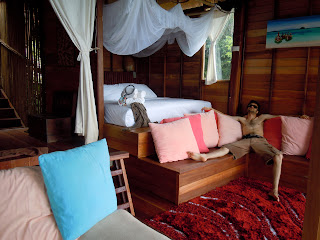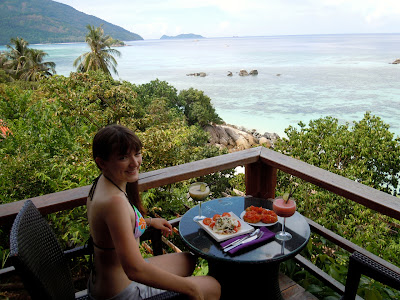Konbanwa!
It's a rainy Sunday evening in Nagoya and I'm enjoying the leisurely temperature of 55 degrees. We've entered the ephemeral transition between gluing ourselves to the gas heater and sweating buckets and killing cockroaches. It's such a perfect temperature, I'll be sad once it's gone!
Today, Stephen and I rode our bikes against the wind and downpour to a great Okinawan cafe in Osu Kannon. I made the mistake of purchasing a plastic umbrella from the nearby convenience store ("combini") which immediately turned into a jagged mess of umbrella innards. I was delighted, though, with all the reactions I got holding it with one hand all the way there.
Unfortunately, I lose every umbrella I buy and am therefore frequently stranded without shelter. Yesterday I felt guilty as I half-considered taking the stray one I saw at the ATM. As I've mentioned and is generally known about Japan, people don't take what doesn't belong to them. It's a comfortable place to live for that reason, and if you lose your wallet it's highly plausible that some honest person will bring it, unviolated, to the police. So as I stood in line eying the nicely embroidered pink umbrella (that obviously hadn't ever turned inside-out), I realized that I couldn't be the stereotypical foreigner obstructing the holy moral law. Even if only in my own perception. Living in Japan will fine-tune your awareness of social propriety (even if it means you have to mummify your head in a sheer scarf to avoid getting soaked). It will also make you realize how blunt the characters are on American TV shows!
Anyway, apart from weighty moral dilemmas, life has been bright and happy. Our new contracts began last Tuesday (after a couple of irregular weeks full of fairly brainless trainings and annual meetings) and we've since had all our new classes. I'm fortunate this year because I have a lot of fantastic, high level students (as well as a class that I love and carried over from last year) who are very engaged and eager to learn. I'm also teaching a couple news-based courses where we watch CNN and BBC clips and discuss recent stories. It's been rejuvenating to meet new people and have a fresh schedule, and although I loved having the little turds (children) last year, I'm glad to have no regular kids classes. I find that my days are less stressful and more clean without them!
Spring is undeniably the happiest time in Japan. It denotes the arrival of cherry blossoms (sakura) and lighthearted enjoyment for all who attend sakura-reveling parties (hanami). Everything begins with the cherry blossoms here, even the new school year for university students. In early April, our neighborhood Tsurumai park was packed with people sitting on blue tarps beneath the flowers. Everyone was drinking sake and the area was dotted with food-vendors selling corn on the cob, takoyaki (fried octopus), yaki soba (fried noodles), and other hanami refreshments. Since I started training for a half-marathon this August, I've been running most days in the park so have regularly enjoyed the sunshine and happy scenery. At the blossom's peak, we went to Gojo river and the Inuyama festival with friends. It was dubbed the happiest day in Japan because everyone there was clearly having such a great time!

Besides pink blossoms, the new school year, riding our bikes without heavy coats and taking weekly Japanese lessons with our private sensei, we've been singing a lot of karaoke and saying goodbye to fellow teachers and friends leaving Japan. The life of an ECC teacher feels acutely cyclical at this time- new people are arriving and others are leaving at the culmination of Japan's beauty.
This evening I came across a list of things that foreigners miss after leaving Japan. With a year left before we depart on our Southeast Asia/Europe adventure (which should span about six months), I've been thinking about what I'll truly miss about life here.
Here is my
Top Ten list so far:
1) Hot springs and heat-circulating Japanese bathtubs: cheap, heavenly, mentally and physically therapeutic.
2) Sushi (especially conveyer-belt), soba, ramen, miso soup, edamame, taiyaki (fish-shaped pastry filled with sweet red bean paste), takoyaki, onigiri (rice balls with a variety of stuffings), okonomiyaki (Osaka-inspired famous egg/cabbage pancake), even natto (fermented soybeans)
3) Green tea vending machines
4) Karaoke: 24/7, private rooms, and all you can eat/drink deals.
5) Transportation: insanely reliable trains/subways, some of which go 186 mph.
6) Safety (I very rarely feel the need to look over my shoulder, which is very refreshing)
7) General cleanliness
8) Combini: the convenience stores not only have a variety of snack choices but healthy ones.
9) Lunch deals: order a full lunch "set" and often get unlimited coffee, salad, soup, rice, etc.
10) Generally very nice and considerate people!
Others: Cat cafes, ping-pongs (buttons you push to call your server at most bars and restaurants), accessible bike lanes, not having to wear a helmet by law, drinking alcohol in public, trying to read and understand Japanese, seeing eccentric fashion, exaggerated, over-the-top advertisements for coffee and beer, going to the land of the supermarket, buying fresh produce at the farmer's market, izakaya (Japanese-style bars and restaurants), the sakura season, the general obsession with characters (such as Hello Kitty) and their paraphernalia, rice-cookers, and heated toilet seats.
It's so easy to live in Japan. I truly love living here. Of course there are annoying aspects (that's for another post, perhaps), but overall it's going to be hard to leave. Thankfully we'll have enough to look forward to to propel us onto a plane.
Speaking of planes, this weekend brings our journey to Hong Kong! We leave on Sunday morning and are staying for eight days. It's going to be an adventure, and I'm going to write about it afterward, I promise!
-Claire


























































































